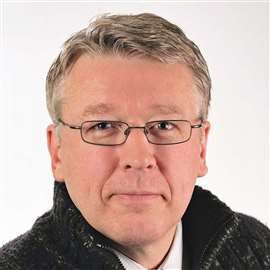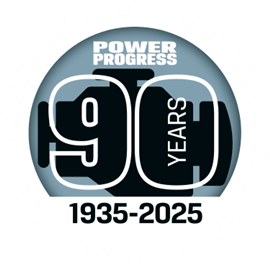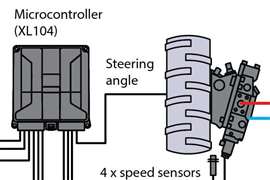Going back 90 years: Diesel Progress February 1938
11 August 2025
America’s first diesel firetruck
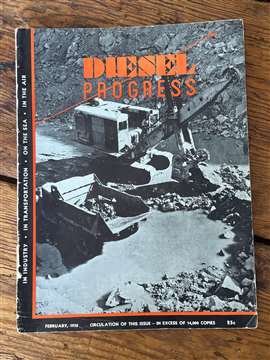 A shovel is shown at work on the February 1938 cover of Diesel Progress, photographed in a quarry near Santa Monica, Calif. It is an Osgood Chief, a two-yard machine built by The Osgood Company in Marion, Ohio. The company advertised that it was more concerned over the “quality of machines it produces than over the quantity,” a strategy that kept it in business until 1954 when it was acquired by the Marion Power Shovel Co. Marion was later purchased by Bucyrus which was later purchased by Caterpillar. While Osgood customers could select from steam, gasoline or electricity-powered equipment over the years, the radiator poking out of the right side of the machine is connected to a Buda diesel engine. The Illinois-based Buda Engine Co. became part of Allis-Chalmers in 1953. The history of today’s AGCO Corp. includes Allis-Chalmers.
A shovel is shown at work on the February 1938 cover of Diesel Progress, photographed in a quarry near Santa Monica, Calif. It is an Osgood Chief, a two-yard machine built by The Osgood Company in Marion, Ohio. The company advertised that it was more concerned over the “quality of machines it produces than over the quantity,” a strategy that kept it in business until 1954 when it was acquired by the Marion Power Shovel Co. Marion was later purchased by Bucyrus which was later purchased by Caterpillar. While Osgood customers could select from steam, gasoline or electricity-powered equipment over the years, the radiator poking out of the right side of the machine is connected to a Buda diesel engine. The Illinois-based Buda Engine Co. became part of Allis-Chalmers in 1953. The history of today’s AGCO Corp. includes Allis-Chalmers.
Starting with the May 1935 issue, Diesel Progress – or Power Progress as it’s known today – has covered engines and engine-powered equipment. Through those nine decades, the writers and editors of this publication have witnessed the adoption of technology that was considered science fiction in the 1930s and they’ve praised (as proper non-biased journalists) the entrepreneurs, executives and especially the engineers that made that progress possible. It’s been – and it continues to be — an amazing thing to watch. Throughout 2025, we will be celebrating those 90 years. With this department, we’re going back to some of the unique applications, forgotten firms and the companies that have been part of the industry and this media company since the beginning of both.
The diesel firetruck
The old custom of taking to a fire a highly explosive load of gasoline with each fire truck has been challenged with the newest development in fire trucks. Instead of a gasoline engine for power, a modern diesel engine is under the “bonnet” of this new truck, and both shop and service tests show many advantages in favor of it.
The fire-fighter is a Stutz model F-D unit with a wheelbase of 173 in. Capable of pumping 1,000 gpm, it represents the latest engineering practices throughout. A six-cylinder Cummins Diesel rated at 155 hp at 1,800 rpm drives the truck through a Fuller five-speed transmission and a Timken worm differential. When at the fire the Cummins drives the geared Stutz positive displacement rotary fire-pump. At 120 pounds pressure its capacity is 1,000 gpm, and at 200 pounds pressure, 500 gallons is discharged. Hydraulic brakes are provided on both the front and rear wheels. Two large reels and two ladders are standard equipment.
The outstanding feature credited to the Cummins Diesel for use in firetrucks is its ability to start instantly regardless of weather conditions – ability to take the load immediately without choking or flooding – immunity to being killed from water getting on ignition wires, or in carburetors because the Diesel has neither – and the reduced fuel consumption.
It is not uncommon for fire trucks, at a stubborn fire, to need refueling. Transferring gasoline under such circumstances is always a risk, whereas with the Cummins Diesel powered fighter the interval between refuelings is only about half as often and when necessary, it can be done without danger of creating another fire.
The diesel used in this new Stutz truck is identical to the thousands of Cummins Diesels operating all over the United States by highway truckers. The engines in highway service have saved millions of dollars for their owners in fuel bills alone, in addition to a marked reduction in maintenance costs.
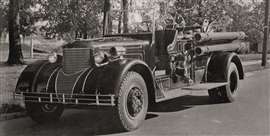 “The diesel firetruck ready for service presents a very efficient, business-like appearance,” read the original caption for this photo from the February 1938 issue of Diesel Progress. Harry C. Stutz was a famous name during the early years of the automobile, and in 1919 he left the Indianapolis-based company he founded and started two new ventures: a new car maker that used his initials – H.C.S. -- as well as the Stutz Fire Apparatus Co. When Columbus, Ind.’s new pumper was built in 1937, it was assembled by the New Stutz Fire Apparatus Co. in Hartford City, Ind. The diesel-powered truck went on a promotional tour before it was placed in service in 1939. Originally equipped with a Cummins HR-6 six-cylinder diesel engine, the pumper was repowered with the same engine model in 1948. Cummins engineers wanted to take a close look at any wear and tear that may have resulted from nine years of firefighting. The fire truck was officially retired in 1974 and is still owned by the Columbus Fire Department.
“The diesel firetruck ready for service presents a very efficient, business-like appearance,” read the original caption for this photo from the February 1938 issue of Diesel Progress. Harry C. Stutz was a famous name during the early years of the automobile, and in 1919 he left the Indianapolis-based company he founded and started two new ventures: a new car maker that used his initials – H.C.S. -- as well as the Stutz Fire Apparatus Co. When Columbus, Ind.’s new pumper was built in 1937, it was assembled by the New Stutz Fire Apparatus Co. in Hartford City, Ind. The diesel-powered truck went on a promotional tour before it was placed in service in 1939. Originally equipped with a Cummins HR-6 six-cylinder diesel engine, the pumper was repowered with the same engine model in 1948. Cummins engineers wanted to take a close look at any wear and tear that may have resulted from nine years of firefighting. The fire truck was officially retired in 1974 and is still owned by the Columbus Fire Department.
This article originally appeared in the March 2025 issue of Power Progress.
POWER SOURCING GUIDE
The trusted reference and buyer’s guide for 83 years
The original “desktop search engine,” guiding nearly 10,000 users in more than 90 countries it is the primary reference for specifications and details on all the components that go into engine systems.
Visit Now
STAY CONNECTED




Receive the information you need when you need it through our world-leading magazines, newsletters and daily briefings.
CONNECT WITH THE TEAM

